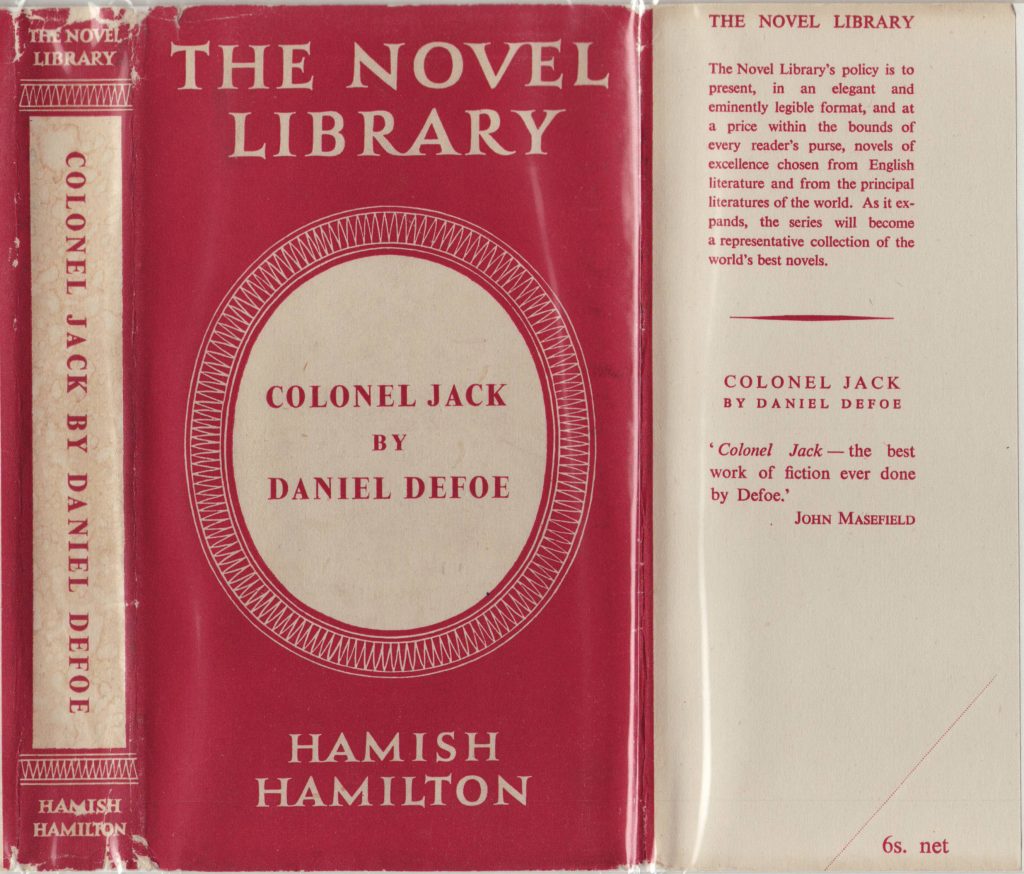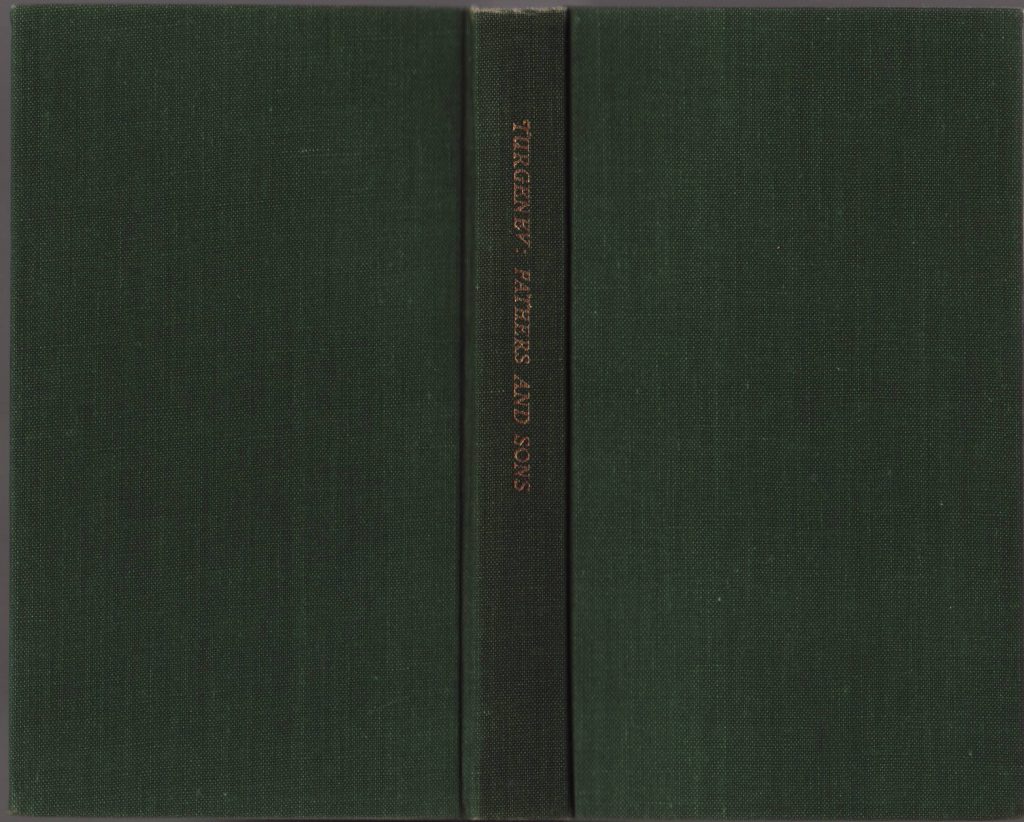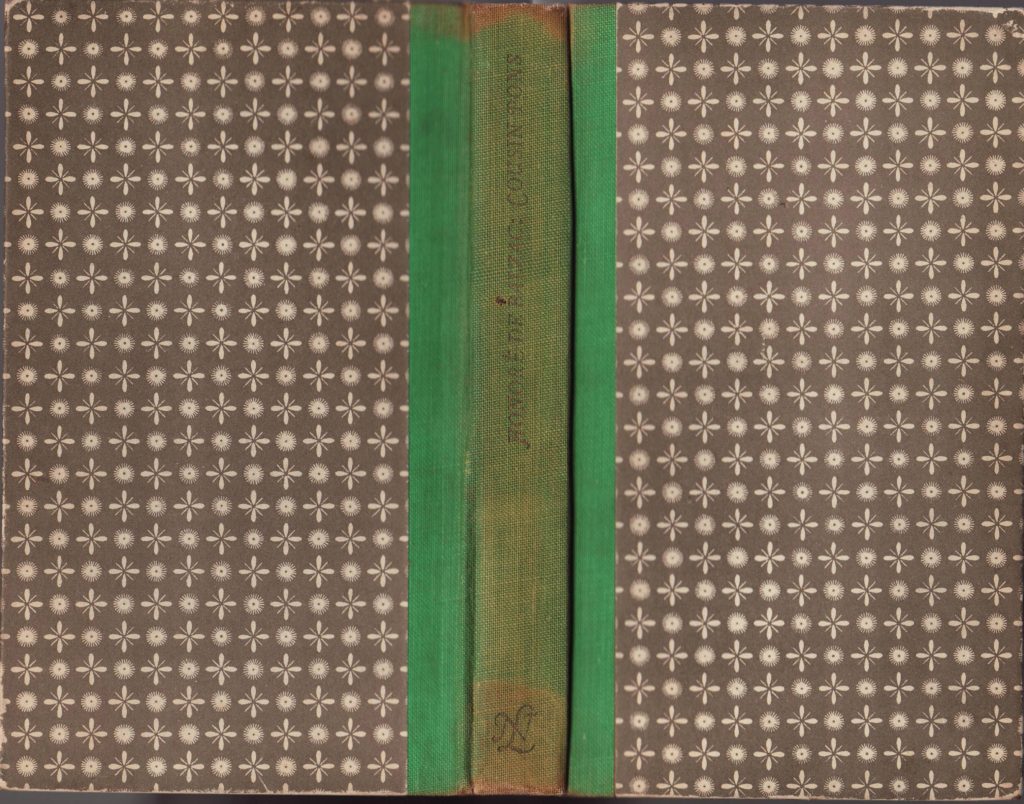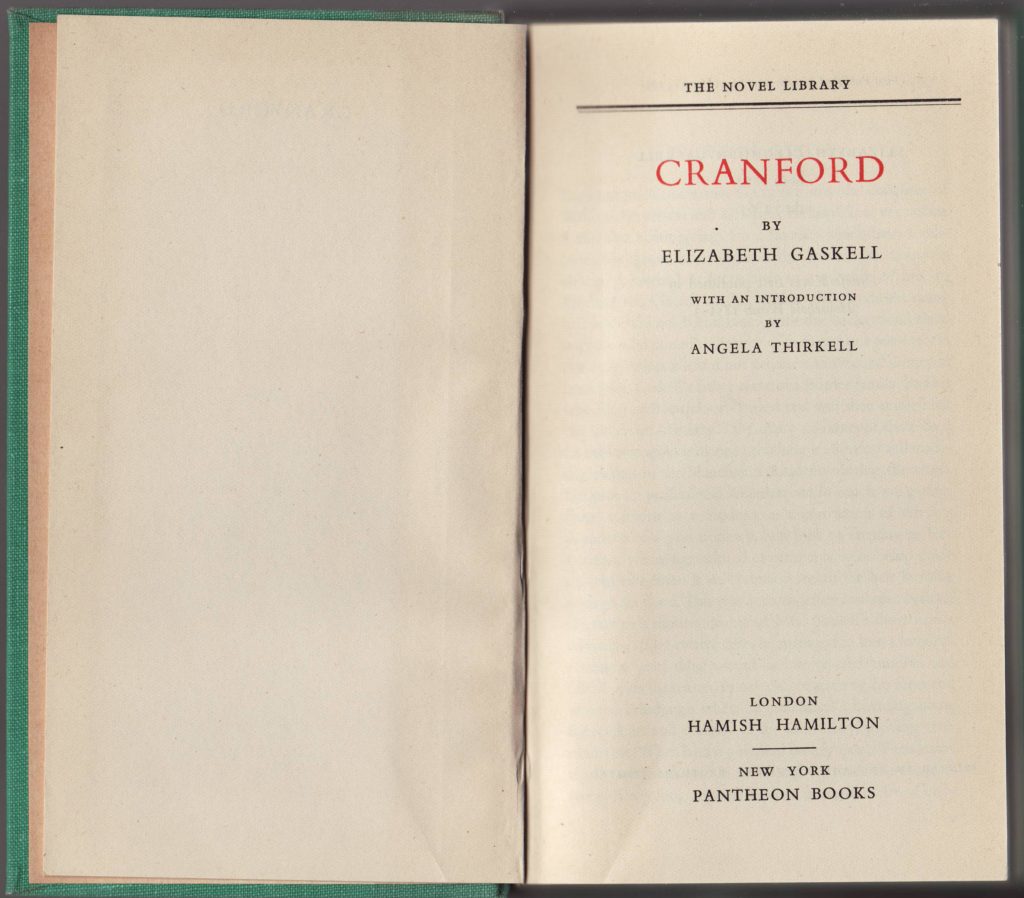Hamish Hamilton (London, UK)
Series dates: 1947-1953
Size: 4″ x 7″
Pantheon Books (New York, U.S.)
Series dates: 1948-1953
Size: 4″ x 7″
 Hamish Hamilton’s Novel Library, which debuted in 1947 in the UK and eventually reached 41 titles, is known for its Oliver Simon / Curwen Press designed jackets and bindings, the incorporation of some quirky new “amateur translations” of continental classic literature (Clive James, The Meaning of Recognition, 2012) as well as introductions from an array of mid-century literary stars.
Hamish Hamilton’s Novel Library, which debuted in 1947 in the UK and eventually reached 41 titles, is known for its Oliver Simon / Curwen Press designed jackets and bindings, the incorporation of some quirky new “amateur translations” of continental classic literature (Clive James, The Meaning of Recognition, 2012) as well as introductions from an array of mid-century literary stars.
The series was published in the U.S. by Pantheon from 1948 until near the end of the series, in 1953, when Citadel Press took over distribution and began to sell the books at a discounted price in the US. No new titles were issued in the US or UK after 1951.
An advertisement in the London Times (June 28, 1946) announces the new series of English and foreign fiction, to be published that winter. The initial twelve titles have a 1947 publication date.
Alan Hodge a poet and literary critic is the editor of the series, and Curwen Press designer Oliver Simon the production editor.
The series reached 41 titles in 1951, after which no new titles were issued. Paper editions of some titles were issued under the name The Novel Library: Continental Edition in 1948-1950. The six Austin titles eventually issued in the series were sold boxed for 36s. net. Some copies of the Austin titles have a leatherette binding.
Despite a captivating jacket and book design, curious translations, substantive introductions and a cheap price, the Novel Library, like many other post-WW2 series, failed by the mid-1950s.
U.K. Editions of the Novel Library
Initially, the Novel Library series had common jackets with a design somewhat inspired by the Curwen Press – the pattern surrounding the oval on the front of the jacket. The series name is on the jacket spine, cover and front flap.
A prospectus for the series lauds the book production and content. This copy of Defoe’s Colonel Jack is dated 1947. A quote about the title is also included on the front jacket flap. Price is 6s. net. There is no series number on the jacket (nor series numbers for the series, it seems).
The back of the jacket lists 24 titles, so likely after a second issuing of 12 titles in later 1947.
The Oliver Simon / Curwen Press design elements are most notable on the binding of the book: the repeating patterns, unique to each title, printed on heavy boards and bound to a cloth spine.
The Curwen Press enlisted many well-known 20th century designers to create repeating pattern papers to be used on endpapers, bindings, and dust jackets. Designers include Lovat Fraser, Albert Rutherston, Margaret Calkin James, Thomas Lowinsky, E.O. Hoppé, Edward Bawden, Paul Nash, Enid Marx, Eric Ravilious, and Harry Carter. A selection of these papers was used on the Novel Library bindings, and eventually, dust jackets. The design of the series is reminiscent of the pre-WW2 Zodiac Books.

A simple half-title page includes only the book title:
A two-color title page is an unusual extravagance for the series:
An informative copyright page includes publication year in the Novel Library along with the author’s dates of birth/death and the first publication of the title.
A copy of Peacock’s Nightmare Abbey and Crotchet Castle from 1947, same design, orange ink:

The orange cover correlates with the repeating Curwen flower pattern on the book’s binding, with contrasting black cloth spine:
In 1948 the Curwen designs are printed on the dust jackets, which are also redesigned with space for the title and author. The front flap includes a prospectus for the series with a summary of the book. The price remains 6s. The spine design remains the same as the earlier jacket. The series titles now have series numbers, and the number is included on the jacket spine.
The back of the dust jacket contains a redesigned list of the 29 titles in the series. Series numbers are included.
The Curwen binding designs are replaced by a common buckram binding with title stamped in gold on this copy. Binding colors at this point include blue (below) yellow, light blue, red, and brick. The binding colors can vary for the same title, the jacket designs don’t.
The inside of the book – half-title, title and copyright pages – remain the same as the 1947 titles.
Three dust jacket designs from 1947: Balzac’s Cousin Bette, Gogol’s Dead Souls and Gorki’s The Artamonov Business:
A 1948 copy of Constant’s Adolphe and The Red Note-Book has modified the dust jacket to include a more formal rectangle on the cover and has added the series name to the front jacket cover again. Otherwise, the jacket design remains the same.
The number of titles on the rear of the jacket is the same 29 as on the other 1948 editions above.
The Curwen pattern is now included on the binding, as with the earlier (1947) printings in the series. The buckram vs. patterned bindings seem random after this time.
A 1949 edition (first in series) of Henry Murger’s Vie De Boheme includes an unusual repeating pattern on the jacket. The front/spine/flap jacket design is otherwise the same as the Constant novel above. The list of titles has expanded to 33. Added to the series are Austen’s Mansfield Park (#30), Sense and Sensibility (#31), Merimee’s Carmen & Colomba (#32) and Maupassant’s A Woman’s Life (#33).
The pattern from the Murger jacket is carried over to the binding.
This 1950 copy of Turgenev’s Fathers and Sons shows no change, besides the pattern on the jacket, in jacket design. 38 titles are listed in the series. Additional titles are Emily Bronte’s Wuthering Heights (#34), Dickens’ Oliver Twist (#35), Turgenev’s Fathers & Sons (shown below, #36), Charlotte Bronte’s Jane Eyre (#37), and Balzac’s Cousin Pons (#38).
The binding for Fathers and Sons is buckram, not patterned:
A 1950 copy of Balzac’s Cousin Pons, with a patterned jacket and binding:
Two more titles were added to the series in 1951: Gaskell’s Cranford (#40) and Daudet’s Sappho (#41). No new titles appear after that date, although a few reprints can be found through the mid-1950s.
U.S. Editions of the Novel Library
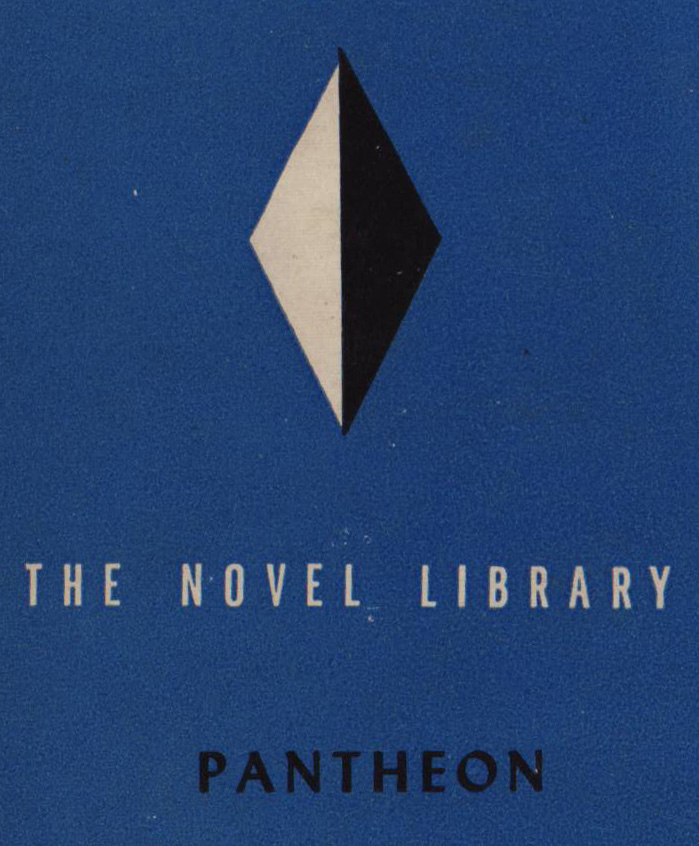 A 1948 volume of The Publishers Weekly (vol. 154) announced that “Beginning in October, Pantheon Books will publish in this country the books of the Novel Library, published in England by Hamish Hamilton. The series will make available at a low price, $1.75, a number of classic novels…”
A 1948 volume of The Publishers Weekly (vol. 154) announced that “Beginning in October, Pantheon Books will publish in this country the books of the Novel Library, published in England by Hamish Hamilton. The series will make available at a low price, $1.75, a number of classic novels…”
Pantheon redesigned the jackets for the U.S. issue of the Novel Library. An undated, but probably 1948 issue of Stevenson’s The Master of Ballantrae. A completely new jacket with a simple geometric logo and series name is included on the front of the jacket. The spine contains the series name and Pantheon imprint. The series prospectus is on the front jacket flap, stressing then new translations that are included in the series. Price is $1.75.
According to the back of the jacket, six titles have been published, and six more are forthcoming; all are from the U.K. series:
The bindings are the same as the U.K. editions with the Curwen patterns.
The half-title page deletes the book title and includes the Pantheon logo:
Title pages are similar to the U.K. versions, but Pantheon replaces Hamish Hamilton as the imprint.
The copyright page follows the same pattern as the U.K. version. The book was printed in the U.K.
A 1949 copy of James’ The Awkward Age is similar in design to the Stevenson, but in blue.
Twelve titles are now in print in the U.S. series.
The patterned binding:
The half-title and title page are the same as the Stevenson copy; the date is included on this copy, 1949.
Oddly, a 1951 dated issue of Gaskell’s Cranford reverts to the U.K. design for the series. It’s possible that the series was not selling well, and Pantheon decided to change the design of the jacket. The jacket has the Curwen pattern and same general design as the UK copies. Differences include the Hamish Hamilton imprint on the jacket spine replaced by the series name, and, most likely, a price of $1.75 (clipped on this copy).
The back of the jacket lists up to 38 titles. Two, including Dickens’ Great Expectations (#4), Flaubert’s Madame Bovary (#23) indicate “Not available in the U.S.A.”
A green cloth binding, same design as the UK editions.
Simple half-title page, as per the U.K. editions:
The title page has both the Hamish Hamilton and Pantheon Books imprints, unlike the earlier U.S. copies:
The copyright page remains similar to U.K. editions. This particular book was printed in the U.K.
Despite the charms of the series – the Curwen inspired book design, quirky new translations, and decent book quality, the series was apparently not selling well. A note in a 1953 issue of Publishers Weekly (vol. 163) announces that “the Citadel Press has taken over, as of April 1, the American distribution of the Novel Library published in England by Hamish Hamilton. Formerly priced at $1.75 a volume, the Novel Library will be re-priced to sell at 75 cents each….”
There is no evidence that Citadel Press published the Novel Library in the U.S. under their own imprint. Rather, it seems they were distributing remaindered copies of the series.
A few titles in the U.K. series are reprinted in 1952, but by and large, it seems the series ends at this point and books in the series are remaindered.
